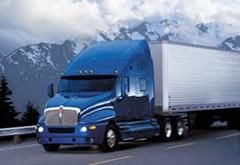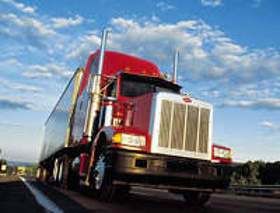Rookies, What Would You Do?
Topic 5345 | Page 7

What is all this fuss about legal vs illegal? DOT is not your friend, there is nothing unethical about running 40 pounds over. They just cause you to lose time and money.
Remember DOT is bad.
DOT is not the enemy. Would you like an unsafe truck driving next to your family? Yeah it can be a pain to be pulled in for an inspection when you are in a hurry but they also have a job to do. I have never had an unpleasant experience with any DOT officer.
DOT:
Department Of Transportation
A department of the federal executive branch responsible for the national highways and for railroad and airline safety. It also manages Amtrak, the national railroad system, and the Coast Guard.
State and Federal DOT Officers are responsible for commercial vehicle enforcement. "The truck police" you could call them.

Also, be sure to remember that moving the fifth wheel distributes weight between the Drives and the Steer axle only. It has no effect on the Trailer tandems. If you move the fifth wheit l towards the truck you're putting the front of the trailer closer to your steer tires so you're adding weight to them. Likewise, if you're moving the fifth wheel back you're putting the front of the trailer away from the steer tires and onto the drive tires - so you're taking weight off of the steer axle and putting it on the drives.
I would like to add a side note to this statement. There are some companies, such as Crete Carrier, that have a fixed fifth wheel. For the newbies, this means you can not slide the fifth wheel because it is bolted down.
Tandems:
Tandem Axles
A set of axles spaced close together, legally defined as more than 40 and less than 96 inches apart by the USDOT. Drivers tend to refer to the tandem axles on their trailer as just "tandems". You might hear a driver say, "I'm 400 pounds overweight on my tandems", referring to his trailer tandems, not his tractor tandems. Tractor tandems are generally just referred to as "drives" which is short for "drive axles".
Tandem:
Tandem Axles
A set of axles spaced close together, legally defined as more than 40 and less than 96 inches apart by the USDOT. Drivers tend to refer to the tandem axles on their trailer as just "tandems". You might hear a driver say, "I'm 400 pounds overweight on my tandems", referring to his trailer tandems, not his tractor tandems. Tractor tandems are generally just referred to as "drives" which is short for "drive axles".

Yes, so far (in 18 months of driving), I have never had a tractor with a sliding 5th wheel.
Also, I have hauled two different loads that were similar to the scenario described by Daniel B. Since I was not over on the Gross Weight (under 80,000 lbs) and only minimally over on the trailer tandems (in my case, they were slid all the way to the back), I drove with the loads. Fortunately, nothing bad came from it.
I had been told by a couple of veteran drivers that DOT was more concerned about being over on the total gross, rather than being over a little on the tandems. Now, I realize that listening to advice from random truckers can mean trouble, but it sounded reasonable to me. I did not have to cross over scales with either load, but did cross a couple of WIM (weigh in motion) sites without incident. However, had I encountered a legalistic DOT officer, things could have ended differently.
And, yes, had my situations been exactly what was described by Daniel B., I would have done exactly what he did (easy to say now, lol!).
Tandems:
Tandem Axles
A set of axles spaced close together, legally defined as more than 40 and less than 96 inches apart by the USDOT. Drivers tend to refer to the tandem axles on their trailer as just "tandems". You might hear a driver say, "I'm 400 pounds overweight on my tandems", referring to his trailer tandems, not his tractor tandems. Tractor tandems are generally just referred to as "drives" which is short for "drive axles".
Tandem:
Tandem Axles
A set of axles spaced close together, legally defined as more than 40 and less than 96 inches apart by the USDOT. Drivers tend to refer to the tandem axles on their trailer as just "tandems". You might hear a driver say, "I'm 400 pounds overweight on my tandems", referring to his trailer tandems, not his tractor tandems. Tractor tandems are generally just referred to as "drives" which is short for "drive axles".
DOT:
Department Of Transportation
A department of the federal executive branch responsible for the national highways and for railroad and airline safety. It also manages Amtrak, the national railroad system, and the Coast Guard.
State and Federal DOT Officers are responsible for commercial vehicle enforcement. "The truck police" you could call them.

What is all this fuss about legal vs illegal? DOT is not your friend, there is nothing unethical about running 40 pounds over. They just cause you to lose time and money.
Remember DOT is bad.
DOT isn't bad, they're just a pain in the butt at times.
DOT:
Department Of Transportation
A department of the federal executive branch responsible for the national highways and for railroad and airline safety. It also manages Amtrak, the national railroad system, and the Coast Guard.
State and Federal DOT Officers are responsible for commercial vehicle enforcement. "The truck police" you could call them.

If they wouldnt notice the 3" from 12th to 13. 13th. Why do they have that law? Unbiased answers if at a possible please.

If they wouldnt notice the 3" from 12th to 13. 13th. Why do they have that law? Unbiased answers if at a possible please.
This is actually a regulation. Congress enacts the law, it's up to the Executive branch to figure out how that law is to be applied. It's up to the Agency or Department, i.e. DOT , EPA, FDA, etc., to set the rule. They can't be vague about it. In this case the Federal government has allowed individual states to regulate this part of the law. Take the speed limit. The regulatory agency has to define what is speeding. A car going fast doesn't really tell you anything. (My mom thought going over 40 on the Interstate was speeding). So the numerical value is placed on the road. A state might have decided 55 is a safe speed. So if you're going 58 you are speeding by definition. However is 3 miles over the speed limit dangerous if the road conditions are good and the weather nice? Yes you could be stopped for speeding but chances are that you won't. I hope this helps.
DOT:
Department Of Transportation
A department of the federal executive branch responsible for the national highways and for railroad and airline safety. It also manages Amtrak, the national railroad system, and the Coast Guard.
State and Federal DOT Officers are responsible for commercial vehicle enforcement. "The truck police" you could call them.
Interstate:
Commercial trade, business, movement of goods or money, or transportation from one state to another, regulated by the Federal Department Of Transportation (DOT).

Its not uncommon for a district to set unreasonably low speed limits to increase city revenue. City officials in Columbus Ohio were called out for changing the timing on the yellow light on traffic lights that have red light cameras to increase the number of tickets. That creates a much less safe situation.
Safety is a buzz word that people in power use to con the commoners into handing their freedom to them on a silver platter and then beg for more.

But this kind of situation is why veteran drivers kinda smile when new drivers say, "I'm going to run 100% legal no matter what." It's a noble intention, but unfortunately it isn't realistic. Once Daniel was loaded at the shipper he had to drive to a truck stop to weigh it. He had no way of knowing he was illegal on his axle weights until he could get to the truck stop to weigh it. If he would have been pulled over and weighed he would have gotten a ticket for being overweight. That's one of the classic "gray areas" where drivers run illegally and everyone knows it but there is no solution to the problem. Until you can get to a scale there's no way to know if your weight is legal or not.
This perfectly states my experiences over the last 8 years as well. Driving for a heavy-haul company we don't deal with tandems on trailers as most of ours are three + drop or fixed four axles. But we deal with axle group and bridge weights everyday. 40 lbs on an axle group is nothing when you're gross is over 103,000 lbs and your four-axle group can have 51,000 lbs.
Shipper:
The customer who is shipping the freight. This is where the driver will pick up a load and then deliver it to the receiver or consignee.
Tandems:
Tandem Axles
A set of axles spaced close together, legally defined as more than 40 and less than 96 inches apart by the USDOT. Drivers tend to refer to the tandem axles on their trailer as just "tandems". You might hear a driver say, "I'm 400 pounds overweight on my tandems", referring to his trailer tandems, not his tractor tandems. Tractor tandems are generally just referred to as "drives" which is short for "drive axles".
Tandem:
Tandem Axles
A set of axles spaced close together, legally defined as more than 40 and less than 96 inches apart by the USDOT. Drivers tend to refer to the tandem axles on their trailer as just "tandems". You might hear a driver say, "I'm 400 pounds overweight on my tandems", referring to his trailer tandems, not his tractor tandems. Tractor tandems are generally just referred to as "drives" which is short for "drive axles".
OWI:
Operating While Intoxicated

Awesome topic, great discussion.helped me learn!
New Reply:
New! Check out our help videos for a better understanding of our forum features

















Preview:
This topic has the following tags:
Life On The Road Safe Driving Tips Truck Equipment Questions Understanding The Laws







 TT On Facebook
TT On Facebook
In the beginning of your career especially that's a great idea. Until you really know how things are done out there it's best to get advice anytime you can. Just make sure all advice or instructions you get from your company is over the Qualcomm (the satellite communications tool drivers use to send messages back and forth to their company - basically like email). That's the equivelant of getting it in writing because those messages are archived for a very long time. If you were given instructions by dispatch over the Qualcomm then you're protected from the "he said/she said" catastrophe if you get busted doing something you were told to do over the phone.
At the same time....if you ever have to have an "off the record" conversation with dispatch, and you will, do it on the phone. Don't put anything on that Qualcomm if you wouldn't want it to be part of an official record.
The reason Daniel didn't inform his company, and I wouldn't have either, is because there's a chance they would have told him to take it back to the shipper. Unless he jumped up and down about it they probably wouldn't have paid him for his time or those miles. And I don't know what his schedule was but he runs really hard and that extra time might have thrown off his logbook and delivery schedule entirely.
So in the real world, for a veteran driver, the most common outcome would be to put it at the 13th hole and run with it. But as a new driver you should consult with your company before ever making those type of decisions.
There are a lot of gray areas in trucking.....a lot of em.
Logbook:
A written or electronic record of a driver's duty status which must be maintained at all times. The driver records the amount of time spent driving, on-duty not driving, in the sleeper berth, or off duty. The enforcement of the Hours Of Service Rules (HOS) are based upon the entries put in a driver's logbook.
Shipper:
The customer who is shipping the freight. This is where the driver will pick up a load and then deliver it to the receiver or consignee.
Qualcomm:
Omnitracs (a.k.a. Qualcomm) is a satellite-based messaging system with built-in GPS capabilities built by Qualcomm. It has a small computer screen and keyboard and is tied into the truck’s computer. It allows trucking companies to track where the driver is at, monitor the truck, and send and receive messages with the driver – similar to email.HOS:
Hours Of Service
HOS refers to the logbook hours of service regulations.